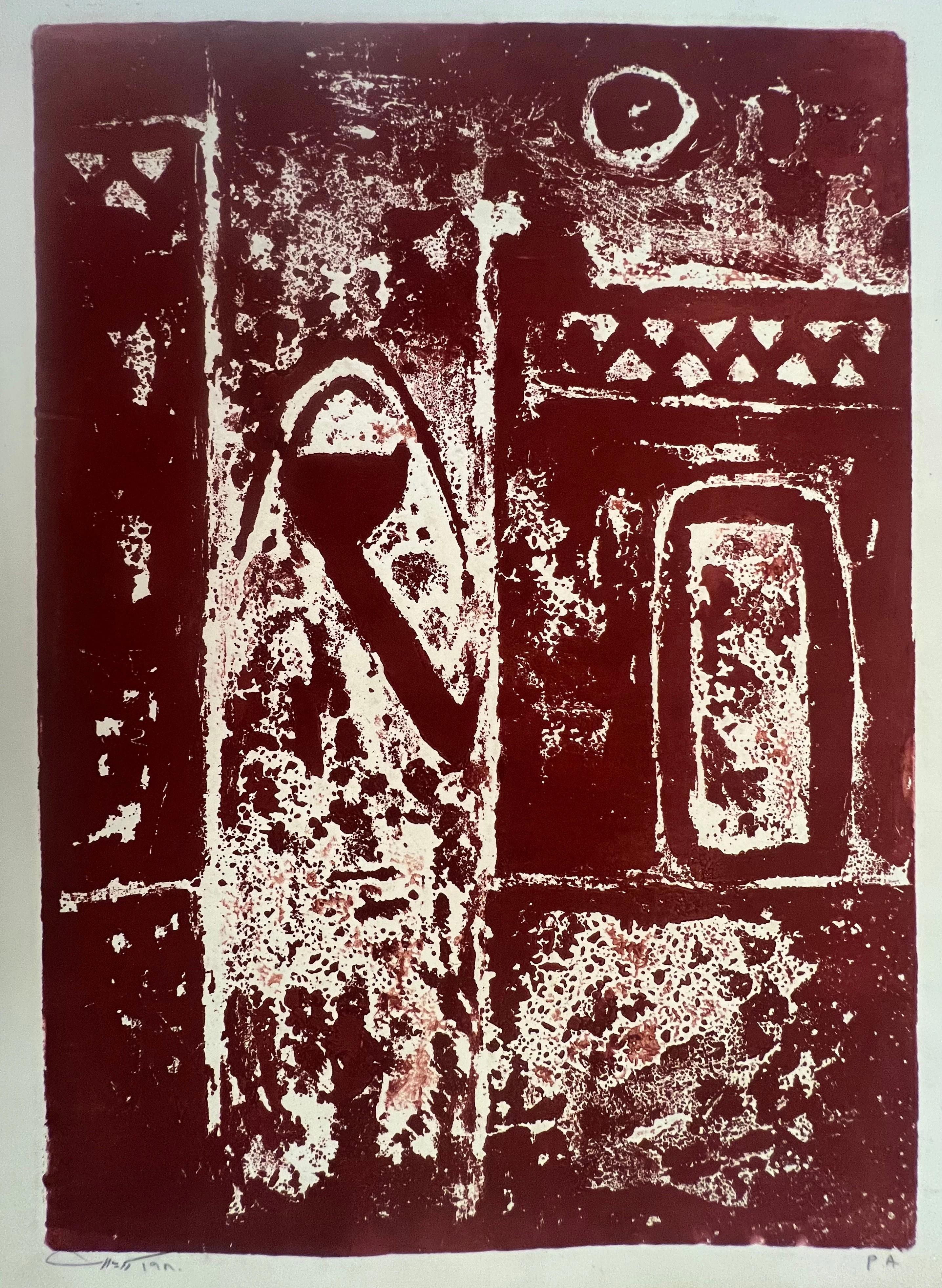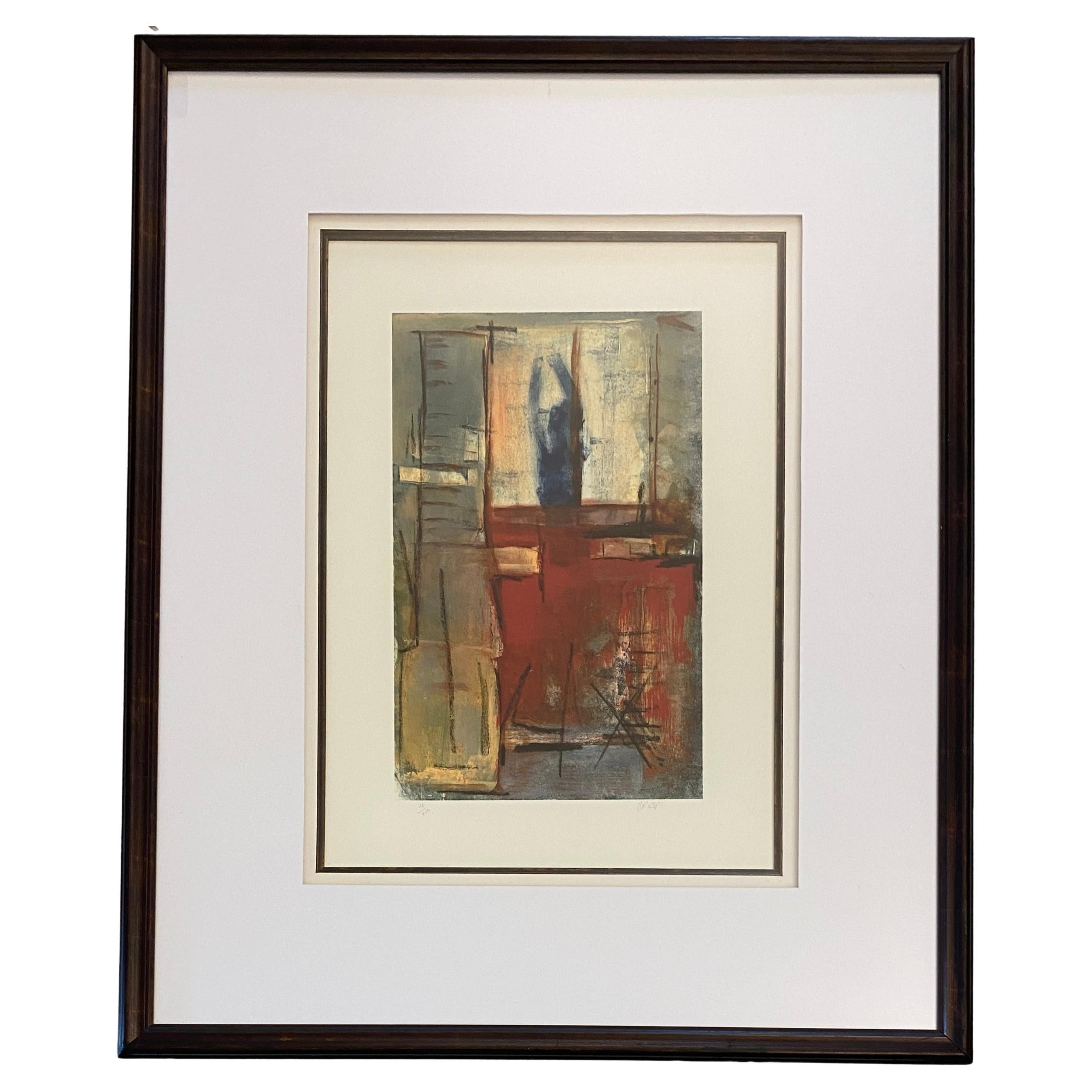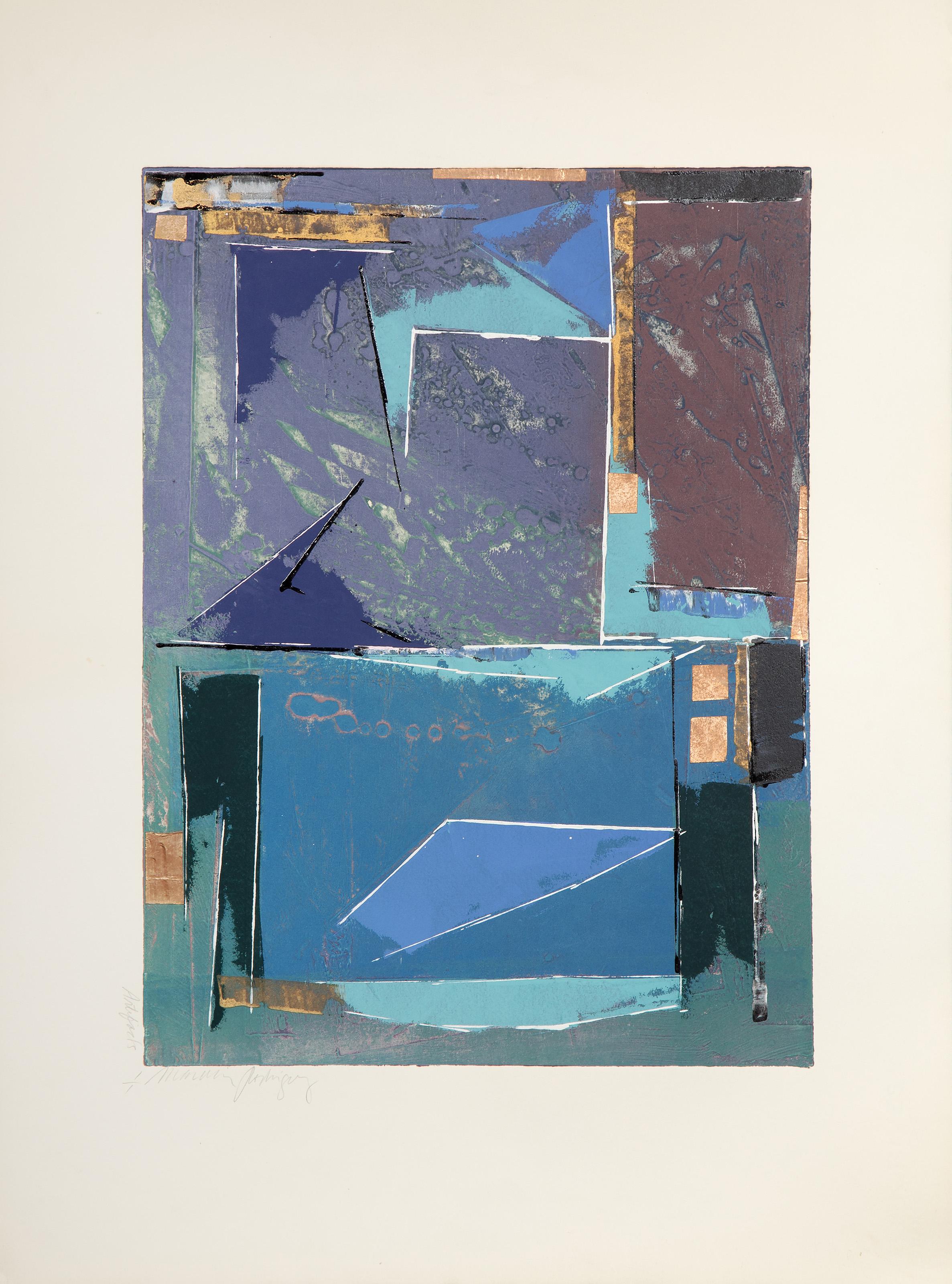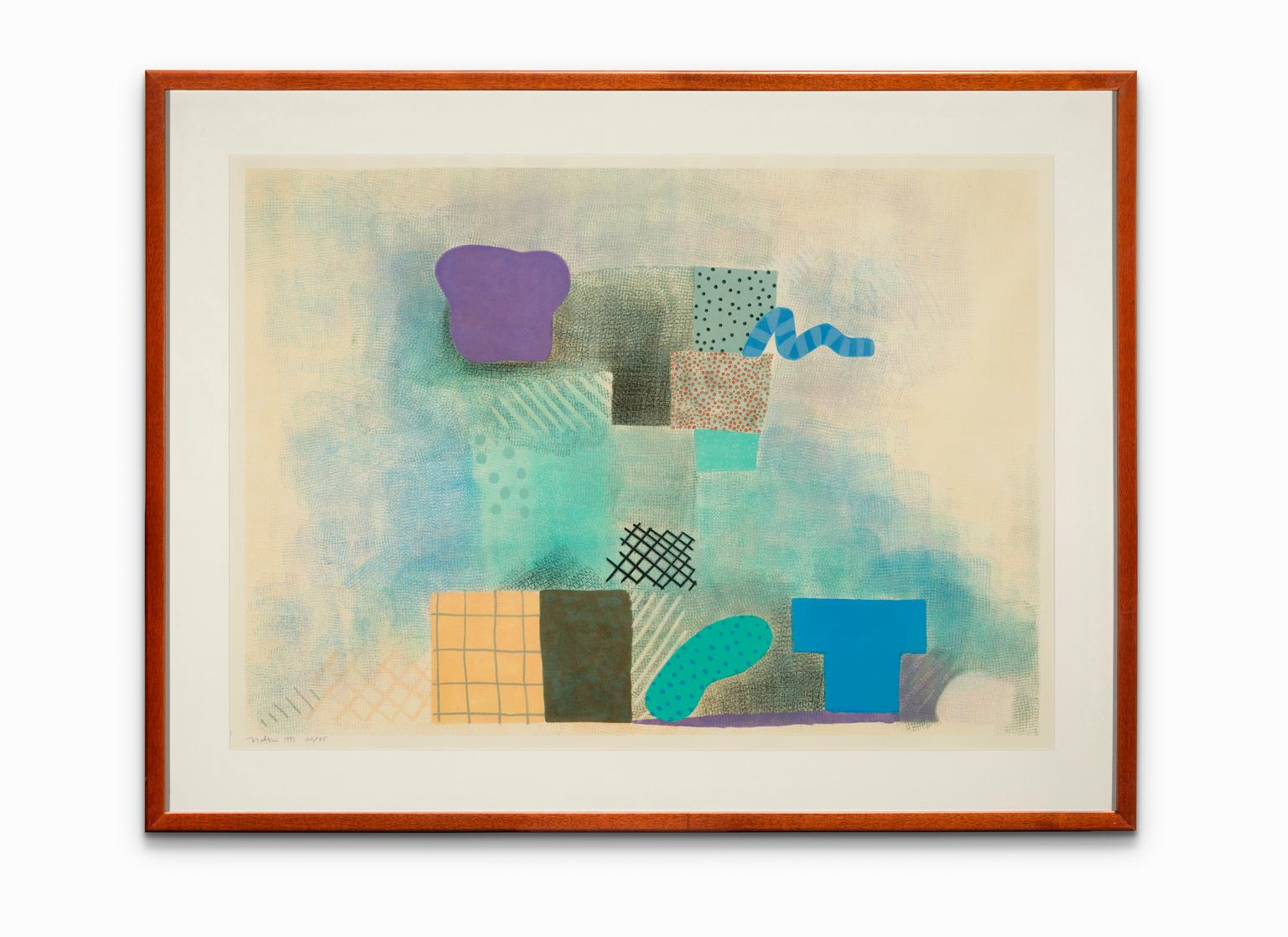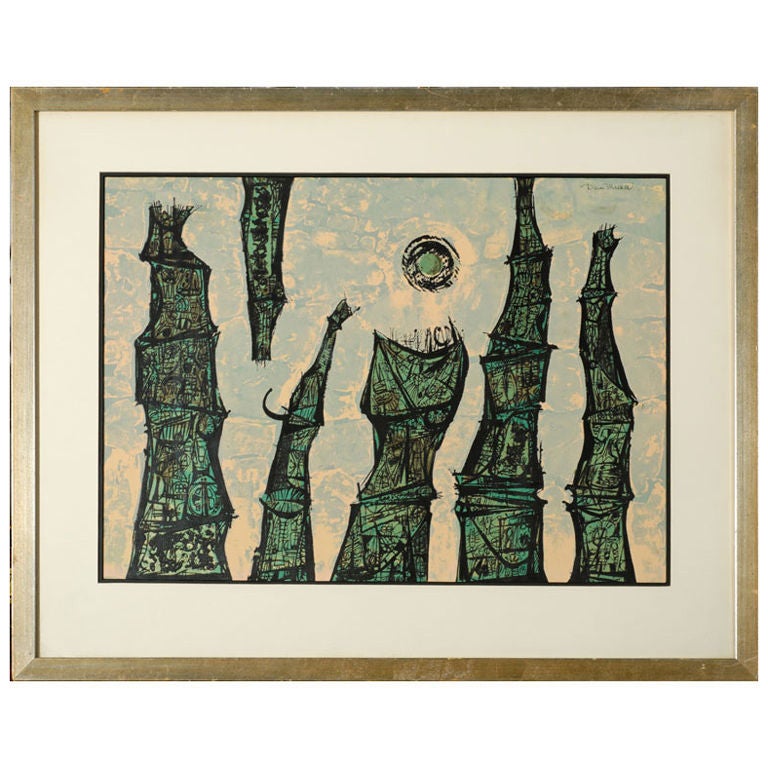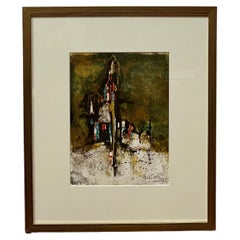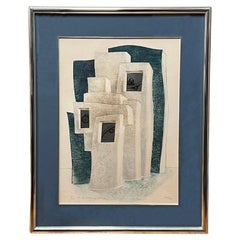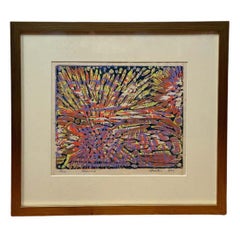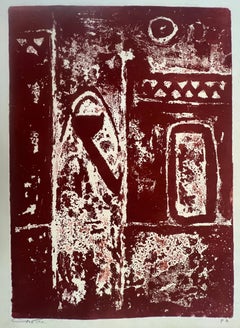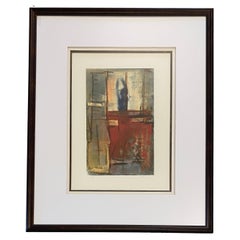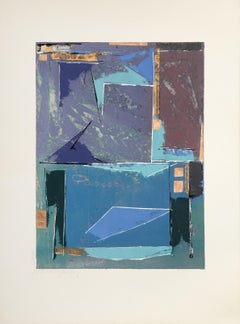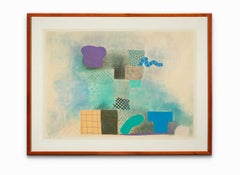Items Similar to "Memory of an Ancient City" Semi-Abstract Lithograph by Beckford Young
Want more images or videos?
Request additional images or videos from the seller
1 of 14
Beckford Young"Memory of an Ancient City" Semi-Abstract Lithograph by Beckford Young1969
1969
$1,600
£1,234.85
€1,405.81
CA$2,284.66
A$2,491.87
CHF 1,313
MX$29,884.16
NOK 16,532.38
SEK 15,424.38
DKK 10,498.89
About the Item
In this semi-abstract lithograph, numbered 4/25, artist Beck Young explores how memory shapes our inner worlds and environments. At the heart of the composition is glowing, patinated gold—a symbol of the vivid present, alive and beating. This luminous center radiates warmth and immediacy, like a pulse within the artwork.
Cooler blue tones surround this core, creating a subtle contrast. They represent the ruins of memory—fragments of the past that remain etched not only in our minds but also in the world around us. These blue zones suggest forgotten cities, personal histories, or shadowy places that continue to shape our experience, even as they fade.
The composition is layered and architectural, with interlocking forms resembling maps, ruins, or symbolic codes. Some shapes are open and marked, others are closed and silent, together forming a kind of mental landscape, where memory and imagination blur.
As Italo Calvino wrote in Invisible Cities:
“Memory is like a city: it has its clear avenues and shadowy alleys, sharp perspectives and dead ends...”
This artwork invites the viewer into that city, where the present burns at the center and memory surrounds us like the walls of half-remembered places.
BIOGRAPHY
Beckford Young became associated with the American Abstract Artists after returning from an extended European stay. The son of a builder in Petaluma, California, Young learned carpentry at an early age, and while still in his teens, built a house on his own. A high school athlete, Young passed up a football scholarship. Instead, he attended the University of California at Berkeley, where John Haley and Worth Ryder influenced him. Ryder, Hans Hofmann's former student in Munich, arranged the summer teaching position that first brought Hofmann to the United States. (1) And it was Ryder who introduced Young to Hofmann's ideas. When Hofmann himself arrived in Berkeley, he took Young under his wing. Hofmann advised Young to forget everything he had learned and draw using only ink and a matchstick. When Hofmann returned to Germany, he convinced Young to join him, although when Hofmann decided to move permanently to the United States, his student remained abroad. In Berlin, he met and married Janet Todd. From Germany, the couple traveled to Rome and Positano, the art colony on the coast of Italy, where Vaclav Vytlacil held summer classes. Later, Young described his time in Positano as his most creative and prolific period. However, little of the work from that time remains today. In Positano, Young worked closely with Vytlacil and studied fresco painting, attempting to duplicate ancient Pompeian techniques.
In 1937, with the political situation worsening in Europe, the Youngs returned to California, where Beckford joined the WPA. (2) His newly acquired expertise in fresco led to immediate employment on mural projects for federal buildings in the San Francisco Bay area. In 1938, he transferred to the Sacramento project, where he organized an art school and gallery. Although he also taught painting, his primary responsibilities in Sacramento were administrative. Subsequently, Young managed various WPA projects in Oakland and San Francisco, where he served as art director until the WPA ended.(3)
Young was deeply committed to the WPA's concept of public art. He believed art should be integrated with life and contribute positively to the community. Much of his work on the WPA was directed toward educating children about the beauty and enjoyment of creating works of art.
During World War II, Young did camouflage work for the armed forces and served in other art-related fields. In the 1950s and 1960s, he completed mural commissions for various hotels and other public spaces. He also worked for a residential construction firm and, during the early 1960s, handled remodeling projects for the Hilton Hotel chain.
Living in California, Beckford Young was a long-distance member of the American Abstract Artists and exhibited in several of its early annual exhibitions. He considered himself an experimental, rather than an abstract artist, who incorporated Hofmann's ideas into a work that was primarily representational. The dramatic white Construction, in which the artist attached architectural moldings, strips of wood, and other found objects to a door, was unusual for Young. It owes a conceptual debt to Russian Constructivism, yet is stylistically closer to Vytlacil's constructed work of the 1930s than to that of Pevsner, Gabo, or Tatlin. Young's admiration for Vytlacil is perhaps most clearly revealed in the Untitled gouache of about 1938. The compressed space of the figures, defiant of the implied dimensionality of the brick foreground and building, relates directly to a short-lived classical phase of Vytlacil's work during the 1930s.
1. The biographical information about Beckford Young is drawn from an interview with Young's widow, Eleanor, and his children Gayle, Mark, and Beckford, Jr., conducted by Mary Drach, March 1988, curatorial files, National Museum of American Art, Smithsonian Institution, Washington, D.C.
2. Beckford Young spoke at length about the California WPA art programs and his role in them in an interview with Mary McChesney, 19 May 1965, Archives of American Art, Smithsonian Institution, Washington, D.C.
3. Young directed projects such as a mosaic mural at the University of California by Helen Bruton and Florence Swift, the Beach Chalet murals by Lucien Lebaudt, and murals at Treasure Island and the San Francisco Federal Building. He also oversaw various sculptural and mural projects at the San Francisco Aquatic Park.
- Creator:Beckford Young (1905 - 1979, American)
- Creation Year:1969
- Dimensions:Height: 24.75 in (62.87 cm)Width: 28.25 in (71.76 cm)Depth: 1.25 in (3.18 cm)
- Medium:
- Movement & Style:
- Period:
- Condition:
- Gallery Location:Pasadena, CA
- Reference Number:1stDibs: LU654316247572
About the Seller
5.0
Vetted Professional Seller
Every seller passes strict standards for authenticity and reliability
Established in 1999
1stDibs seller since 2017
80 sales on 1stDibs
Typical response time: Several days
- ShippingRetrieving quote...Shipping from: Pasadena, CA
- Return Policy
More From This Seller
View AllAbstract Lithograph by Johnny Friedlander
Located in Pasadena, CA
Art, a tangible manifestation of the imaginary and the sensitive, is translated through works capable of captivating and communicating beyond words. Friedlaender's lithographs, loade...
Category
Mid-20th Century Abstract Expressionist Abstract Prints
Materials
Lithograph
$600 Sale Price
20% Off
"Dans le Royaume des Perles" Colored Etching by Shoichi Hasegawa # 19/110
Located in Pasadena, CA
Shoichi Hasegawa, is a world-renowned Japanese engraver and painter born in Yaizu in 1929. He moved to Paris in 1961 to hone his etching technique. He quickly gained recognition by ...
Category
Late 20th Century Abstract Prints
Materials
Etching
The Milestones of Atlantis, Lithography
Located in Pasadena, CA
This textural lithograph called "The Milestones of Atlantis" portrays a group of stone pillars creating a harmonious whole that may represent some kind of checkpoint. The soft palet...
Category
Late 20th Century Abstract Expressionist Prints and Multiples
Materials
Lithograph
"Phoenix" Lithograph by Richard Proctor
Located in Pasadena, CA
An exploration into symbolism and color for this lithograph numbered 2/60, signed and dated by Richard Proctor. The artist, whose work we regularly feature, offers us a dazzling illu...
Category
Mid-20th Century Abstract Abstract Prints
Materials
Lithograph
Heart of the World II, Lithograph by John Anthony Miller
Located in Pasadena, CA
"Heart of the World II" (1988), lithograph numbered 11/30, dated and signed by John Anthony Miller, unfolds a tense, dense, and complex world where every centimeter holds a presence....
Category
1990s Post-Modern Figurative Prints
Materials
Lithograph
Abstract Portrait Lithograph by David Segel
By David Segel
Located in Pasadena, CA
Framed lithograph of an abstract portrait of a man; numbered 3/10 by artist David Segel.
After studying at the Carnegie Institute in Pitts...
Category
Mid-20th Century Abstract Prints and Multiples
Materials
Paper, Ink
You May Also Like
"Nubian II" (FRAMED) Abstract Lithograph 20" x 14" in (1980) by Zaccaria Zeini
Located in Culver City, CA
"Nubian II" (FRAMED) Abstract Lithograph 20" x 14" in (1980) by Zaccaria Zeini
Medium: lithograph
Signed and dated
Zaccaria El Zeini (1932 - 1993) was raised in the popular distri...
Category
20th Century Abstract Prints
Materials
Lithograph
Abstract Color Lithograph by Rubin Crespi
Located in Miami, FL
Evoking Emotion: Abstract Lithograph "Woman at the Window" by Rubin Crespi
This captivating abstract color lithograph, titled "Woman at the Window" by Ru...
Category
21st Century and Contemporary Swiss Prints
Materials
Paper
Artifacts IV, Abstract Monoprint and mixed media by Manuel Rodriguez Jr.
Located in Long Island City, NY
Manuel Rodriguez Jr., Filipino (1942 - ) - Artifacts IV. Medium: Monoprint and mixed media on BFK Rives, signed and titled in pencil, Edition: 1/1, Image Size: 20.75 x 15.5 inches, ...
Category
Late 20th Century Abstract Prints and Multiples
Materials
Monoprint
Robert Natkin Abstract Lithograph Signed Numbered
By Robert Natkin
Located in Detroit, MI
SALE ONE WEEK ONLY
Soft pastel colors in floating smudges lay between and around lyrical abstract geometric and organic forms giving a diaphanous color and shape harmony to the work...
Category
1990s Abstract Expressionist Abstract Prints
Materials
Lithograph
Colorful Abstract Expressionist Print By Dean Meeker
By Dean Meeker
Located in Chicago, IL
Dean Jackson Meeker (Madison, Wisconsin, 1920-2002) Dean Meeker was a printmaker painter and teacher. He studied at the Art Institute of Chicago, Northwestern University, and the Uni...
Category
Vintage 1940s American Prints
Abstract Composition - Lithograph- 1970s
Located in Roma, IT
Image dimensions: 38 x 46.5 cm.
Abstract Composition is an original color lithograph on paper realized around the 1970's.
Signed in pencil on lower right margin. Signature not comp...
Category
1970s Abstract Abstract Prints
Materials
Lithograph
More Ways To Browse
Wpa Art California
Pour Roby Etching By Pablo Picasso
Pour Roby
Prince Purple Rain
Pubic Hair
Puccini Poster
Reine De Joie
Rene Magritte Le Fils
Retro Pinup Posters
Rie Munoz
Robert Bane
Rockin Jelly Bean
Roger Hebbelinck
Roy Lichtenstein I Love Liberty
Roy Lichtenstein Liberty
Rudolf Lesch
Sable Mouvant
Salvador Dali Alice

